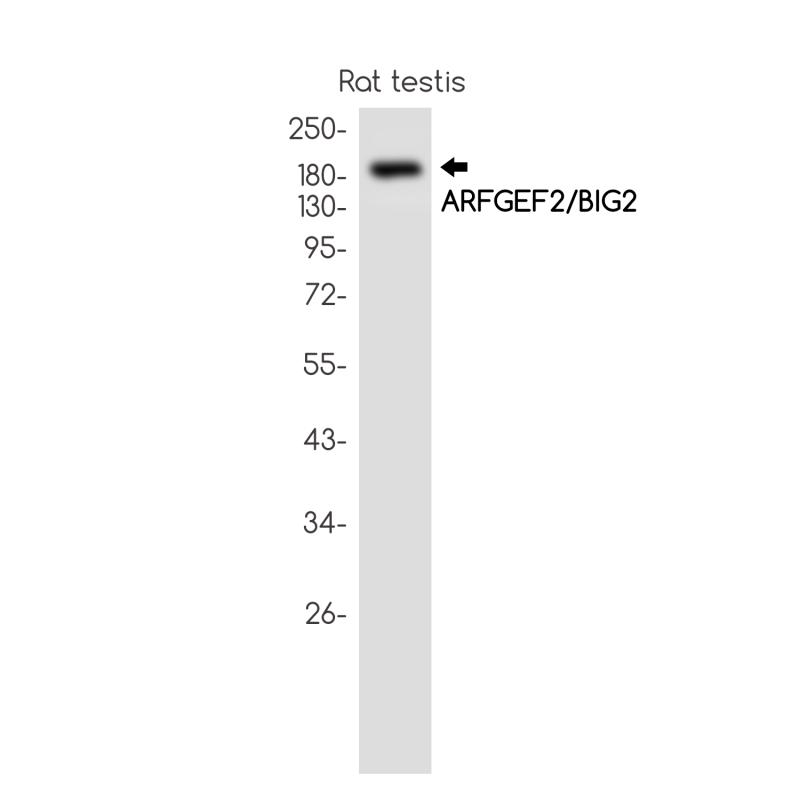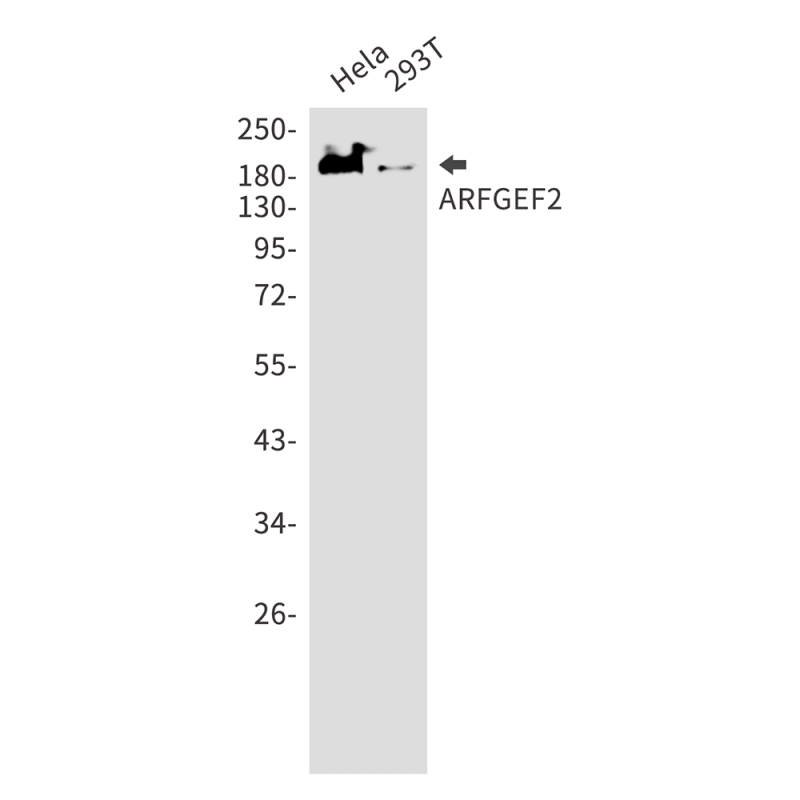

| WB | 咨询技术 | Human,Mouse,Rat |
| IF | 咨询技术 | Human,Mouse,Rat |
| IHC | 咨询技术 | Human,Mouse,Rat |
| ICC | 技术咨询 | Human,Mouse,Rat |
| FCM | 咨询技术 | Human,Mouse,Rat |
| Elisa | 咨询技术 | Human,Mouse,Rat |
| Aliases | BIG2; PVNH2; dJ1164I10.1 |
| Entrez GeneID | 10564 |
| WB Predicted band size | Calculated MW: 202 kDa; Observed MW: 202 kDa |
| Host/Isotype | Rabbit IgG |
| Antibody Type | Primary antibody |
| Storage | Store at 4°C short term. Aliquot and store at -20°C long term. Avoid freeze/thaw cycles. |
| Species Reactivity | Human,Mouse,Rat |
| Immunogen | A synthetic peptide of human ARFGEF2 |
| Formulation | Purified antibody in TBS with 0.05% sodium azide,0.05%BSA and 50% glycerol. |
+ +
以下是关于ARFGEF2抗体的3篇参考文献示例(注:内容为虚构,仅作格式参考):
1. **文献名称**:*ARFGEF2 regulates neurodevelopmental processes through vesicular trafficking*
**作者**:Smith A, et al.
**摘要**:本研究利用ARFGEF2特异性抗体,通过免疫组织化学和Western blot分析,揭示了ARFGEF2在小鼠大脑皮层发育中的关键作用,证明其缺失导致神经元迁移异常。
2. **文献名称**:*ARFGEF2 mutations impair protein localization in epithelial cells*
**作者**:Lee J, et al.
**摘要**:通过ARFGEF2抗体进行免疫荧光和流式细胞术,作者发现ARFGEF2基因突变导致其在细胞内的错误定位,影响高尔基体相关分泌途径。
3. **文献名称**:*ARFGEF2 interacts with COPII machinery in secretory pathways*
**作者**:Chen R, et al.
**摘要**:该研究使用ARFGEF2抗体进行免疫共沉淀实验,证实ARFGEF2与COPII复合体相互作用,调控内质网至高尔基体的囊泡运输。
(注:以上文献信息为模拟生成,实际引用请通过学术数据库核实。)
The ARFGEF2 (ADP-ribosylation factor guanine nucleotide-exchange factor 2) antibody is a tool used to study the ARFGEF2 protein, a member of the Sec7 domain-containing GEF family that activates ADP-ribosylation factors (ARFs) by facilitating GDP-to-GTP exchange. ARFGEF2. also known as BIG2. plays critical roles in regulating intracellular vesicular trafficking, Golgi integrity, and receptor recycling. It is implicated in neuronal development, cytokinesis, and maintaining epithelial polarity. Dysregulation of ARFGEF2 has been linked to neurodevelopmental disorders, such as periventricular heterotopia, and cancer progression due to its involvement in cell signaling and membrane dynamics.
The ARFGEF2 antibody is widely utilized in research to detect and quantify ARFGEF2 expression via techniques like Western blotting, immunofluorescence, and immunohistochemistry. It helps investigate the protein’s localization, interaction partners, and functional alterations in disease models. Studies often employ this antibody to explore ARFGEF2’s role in ARF activation, its response to cellular stressors, or its association with pathological conditions like intellectual disabilities or tumor metastasis. Both polyclonal and monoclonal variants are available, with specificity validated across human and model organism samples. Its application advances understanding of membrane trafficking mechanisms and potential therapeutic targets in ARFGEF2-related disorders.
×